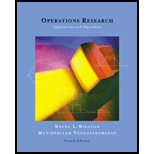
Concept explainers
Explanation of Solution
Solution:
Let,
x1= Number of valves purchased from supplier 1
x2= Number of valves purchased from supplier 2
x3= Number of valves purchased from supplier 3
z= Cost of purchasing valves
The size mix and cost of the valves given in the tale below,
| Supplier |
Cost Per value (S) |
Percent Large |
Percent Medium | Percent Small |
| 1 | 5 | 40 | 40 | 20 |
| 2 | 4 | 30 | 35 | 35 |
| 3 | 3 | 20 | 20 | 60 |
Then, the total cost of the valves can be expressed as,
z=5x1+4x2+3x3
In each month, at least 500 large valves should be purchased. Therefore, the constraint can be written as,
0.4x1+0.3x2+0.2x3≥500
In each month, at least 300 medium valves should be purchased. Therefore, the constraint can be written as,
0.4x1+0.35x2+0.2x3≥300
In each month, at least 300 small valves should be purchased. Therefore, the constraint can be written as,
0
Want to see the full answer?
Check out a sample textbook solution
Chapter 4 Solutions
Operations Research : Applications and Algorithms
- using r language Obtain a bootstrap t confidence interval estimate for the correlation statistic in Example 8.2 (law data in bootstrap).arrow_forwardusing r language Compute a jackknife estimate of the bias and the standard error of the correlation statistic in Example 8.2.arrow_forwardusing r languagearrow_forward
- using r languagearrow_forwardThe assignment here is to write an app using a database named CIT321 with a collection named students; we will provide a CSV file of the data. You need to use Vue.js to display 2 pages. You should know that this assignment is similar, all too similar in fact, to the cars4sale2 example in the lecture notes for Vue.js 2. You should study that program first. If you figure out cars4sale2, then program 6 will be extremely straightforward. It is not my intent do drop a ton of new material here in the last few days of class. The database contains 51 documents. The first rows of the CSV file look like this: sid last_name 1 Astaire first_name Humphrey CIT major hrs_attempted gpa_points 10 34 2 Bacall Katharine EET 40 128 3 Bergman Bette EET 42 97 4 Bogart Cary CIT 11 33 5 Brando James WEB 59 183 6 Cagney Marlon CIT 13 40 GPA is calculated as gpa_points divided by hrs_attempted. GPA points would have been arrived at by adding 4 points for each credit hour of A, 3 points for each credit hour of…arrow_forwardI need help to solve the following case, thank youarrow_forward
 Operations Research : Applications and AlgorithmsComputer ScienceISBN:9780534380588Author:Wayne L. WinstonPublisher:Brooks Cole
Operations Research : Applications and AlgorithmsComputer ScienceISBN:9780534380588Author:Wayne L. WinstonPublisher:Brooks Cole
